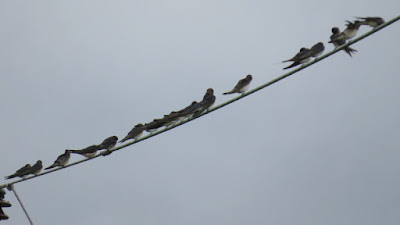A cloudy morning, with a few light showers and a very light north-easterly breeze. Today would turn out to be an excellent one for unexpected visitors.
Things began quietly. A few Siskins called from above the copse at Netherstead, but the excitement started when I got to the field behind the main pool. There were lots of finches and buntings in the hedge and the adjacent wild plant strips. From out of one of these a large bunting took flight, brown rump, no white in the tail, it all added up to a
Corn Bunting. This was the fourth record for the site, and the first at this time of year (they have previously been seen in winter or early spring).
The bird flew to the hedgerow where I managed some record shots.
 |
| Corn Bunting |
When it flew again I could hear its call, a very quiet tic tic, as further confirmation of the record. Later, I flushed it in the field, where it's large size was well demonstrated as it flew with equally large Skylarks.
The hedgerow also contained a Meadow Pipit, probably the same one as the bird on Friday. A better opportunity to get a decent shot of it though.
 |
| Meadow Pipit |
Scanning the field I noticed four Whinchats perched up.
 |
| One of the Whinchats |
I finally got to the flashes, and counted the usual Green Sandpipers, Teal, and Snipe. After a short excursion down the hedge following a party of tits and Chiffchaffs, I returned and discovered a large wader standing in the furthest flash. Grabbing the scope I confirmed it was a juvenile
Black-tailed Godwit, I just had time to line it up for a record shot when it took off.
 |
| That was close! |
I never saw it again, so it must have resumed its migration.
So two year-ticks today. I also counted 11 Whitethroats, 10 Chiffchaffs, three Blackcaps, a Lesser Whitethroat, 50 Greenfinches, 50 Goldfinches, 12 Reed Buntings, eight Yellowhammers, and four Linnets.





























